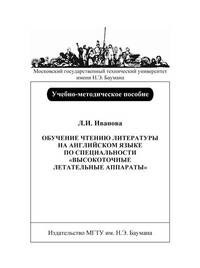Обучение чтению литературы на английском языке по специальности «Высокоточные летательные аппараты»
Покупка
Тематика:
Английский язык
Автор:
Иванова Людмила Ивановна
Год издания: 2007
Кол-во страниц: 44
Дополнительно
Вид издания:
Учебно-методическая литература
Уровень образования:
ВО - Бакалавриат
Артикул: 840506.01.99
Пособие содержит тексты из оригинальной научно-технической литературы на английском языке, словарные блоки, а также лексико-грамматические упражнения, способствующие развитию навыков перевода литературы по специальности и устной речи, связанной с профессиональной проблематикой. Для студентов 3-го и 4-го курсов, обучающихся по специальности «Высокоточные летательные аппараты».
Тематика:
ББК:
УДК:
- 6297: Авиация и космонавтика. Летательные аппараты. Ракетная техника. Космическая техника
- 808: Риторика. Литературное творчество. Редактирование. Культура речи
- 811111: Английский язык
ОКСО:
- ВО - Бакалавриат
- 24.03.05: Двигатели летательных аппаратов
- 25.03.01: Техническая эксплуатация летательных апаратов и двигателей
ГРНТИ:
Скопировать запись
Фрагмент текстового слоя документа размещен для индексирующих роботов
Московский государственный технический университет имени Н.Э. Баумана Л.И. Иванова ОБУЧЕНИЕ ЧТЕНИЕ ЛИТЕРАТУРЫ НА АНГЛИЙСКОМ ЯЗЫКЕ ПО СПЕЦИАЛЬНОСТИ «ВЫСОКОТОЧНЫЕ ЛЕТАТЕЛЬНЫЕ АППАРАТЫ» Учебно-методическое пособие М о с к в а Издательство МГТУ им. Н.Э. Баумана 2 0 0 7
УДК 802.0
ББК 81.2 Англ-923
И20
Рецензент З.А. Заболотская
Иванова Л.И.
Обучение чтению литературы на английском языке по
специальности «Высокоточные летательные аппараты»:
Учеб.-метод. пособие. — М.: Изд-во МГТУ им. Н.Э. Баумана, 2007. — 44 с.: ил.
Пособие содержит тексты из оригинальной научно-технической
литературы на английском языке, словарные блоки, а также лексико-грамматические упражнения, способствующие развитию навыков перевода литературы по специальности и устной речи, связанной с профессиональной проблематикой.
Для студентов 3-го и 4-го курсов, обучающихся по специальности «Высокоточные летательные аппараты».
УДК 802.0
ББК 81.2 Англ-923
© Иванова Л.И., 2007
© МГТУ им. Н.Э. Баумана, 2007
И20
ПРЕДИСЛОВИЕ Пособие, состоящее из трех тематически связанных разделов, содержит учебные материалы: тексты из оригинальной научно-технической литературы на английском языке; словарные блоки, в которые включена главным образом терминология; предтекстовые и послетекстовые лексико-грамматические упражнения, способствующие пониманию и осмыслению прочитанного, развитию навыков перевода литературы по специальности, а также навыков устной речи, связанной с профессиональной тематикой. В конце пособия представлены четыре дополнительных текста, круг заданий к которым формирует преподаватель в зависимости от дидактических задач, стоящих перед ним в конкретных ситуациях. Пособие адресовано студентам старших курсов, обучающимся по специальности «Высокоточные летательные аппараты» и другим машиностроительным специальностям. Оно может быть использовано как для самостоятельной, так и для аудиторной работы под руководством преподавателя.
UNIT I New Words proceеd v продолжать charcoal n древесный уголь sulphur n сера available a имеющийся в распоряжении; доступный purpose n цель, задача charge n заряд expell v выбрасывать, выталкивать projectile n снаряд relate v относиться blasting cap капсюль-детонатор remain v оставаться predict v прогнозировать diatomaceous а диатомовый fuse n запал core n стержень refine v очищать 1. Translate the following word combinations essential ingredients; display and signaling purposes; standard military tool; the early 14th century cannon; black powder charge; the discovery of vast deposits; related developments;
a by-product of soap manufacture; the behavior of NG-based explosives; to remain highly unpredictable; to result in numerous accidents; to absorb up to three times its own weight; leak resistant paste; numerous advances; fertilizer grade ammonium nitrate; shock tube based detonator; water-in-oil emulsion explosives. 2. Try to guess the meaning of the words given in italics by the context. Translate the sentences. 1. But the behavior of the NG-based explosives still remained highly unpredictable resulting in numerous accidents and fatalities. 2. Its use accelerated with the discovery of vast deposits of sodium nitrate in Chile in 1840. 3. In the detonation process a shock front propagates at a characteristic velocity into the unreacted explosive at very high pressures and temperatures. 3. Give the meanings of the international words: initial, incident, powder, ingredients, credit, mixtures, deposits, to be pioneered by, accidents, to absorb, to convert, personnel. 4. Translate the following sentences. Mind the Participle and different meanings of the word “result”. 1. The energy from an open-air explosion results in compression of surrounding air which gives rise to a rapidly propagating shock wave. 2. The additional hazards resulting from an explosion include the explosion fireball, secondary fragments, perforation and spalling.


